FRANCESCO ARENA


A beam situated at the entrance to an alley in the historic center of Monopoli (Puglia, Italy) gave Francesco Arena the idea of using it to hand a swing. In rephrasing the famous introductory line from Tolstoy’s Anna Karenina, “All happy families are alike but every unhappy family is unhappy in its own way,” the artist engraved two phrases on the bronze seat of the swing indicating the two directions in which it travels when in motion. “All present days are alike” and “Every past day is different in its own way.” Anyone using the swing, conceals the writing with their body, but they can make it visible again by uttering the phrase while swinging.
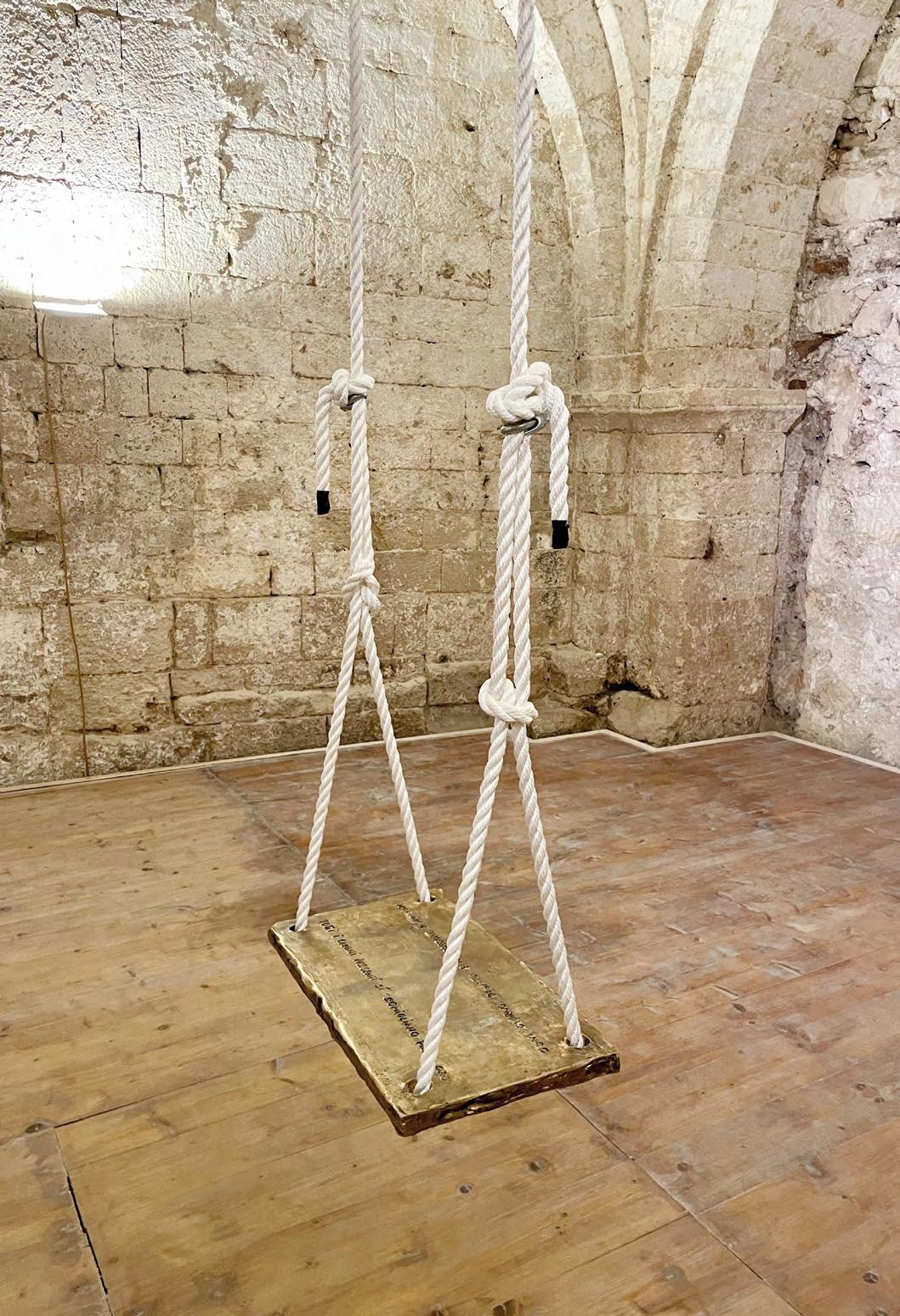

A gold-plated, galvanized bronze bar 10 centimeters in diameter is the same height as the average man, 172.5 cm. Two phrases are engraved along the body of the bar, one phrase runs from bottom to top and the other from top to bottom. The phrase running from bottom to top reads, “The sixty thousand, two hundred and fortieth part of the distance between here and space”. In fact, the height of the bar is precisely the 60,240th part of the 100 kilometres separating the earth’s surface from Karman line that marks the beginning of space.
The sentence that runs from the top to the bottom reads: “The three million eight hundred and twenty-nine thousand five hundred and eighteenth part of the distance between here and the center of the earth”. The height of the bar is precisely the 3,829,518th part of the 6,357 kilometers separating the earth’s surface from the center of the earth itself.

FRANCESCO ARENA
otto
angoli
19 February – 10 April, 2021
Envisaged as an anthology of the artist’s work, the exhibit otto angoli presents eight works which are distinctive in terms of materials and subject matter and have been realized over the course of a long period of time.
In Francesco Arena’s work, the physical characteristics of each type of material correspond to specific poetic needs: stone, bronze, steel, ash are always used in relation to concepts of space and time and the temporal intervals between memorable events in our collective history and the individual events in the artist’s life are translated into units of measure which determine the dimensions and the sense of his sculptures.
The duration, thus, becomes something tangible.
Each of the works presented in this solo exhibit at the Studio Trisorio is installed in one of the eight corners of the exhibit space almost as if to indicate the coordinates of a non-linear temporal path.






Six-meter-long scaffolding pipe bent into a right angle. An audio tape recording of a song by Nirvana, for which the work is entitled, runs through the inside of the pipe. The tortuous path followed by the 60-meter tape becomes a metaphor of a temporal path.
Endless, Nameless, 2020 metal, magnetic audio tape, variable dimensions


An upside-down, three-meter tall copper L is engraved with a phrase by Auguste de Villiers de l’Isle-Adam: “Nous nous en souviendrons de cette planète”(We will remember this planet) which Leonardo Sciascia chose as an epitaph for his tomb translating it into the Italian: “Ce ne ricorderemo di questo pianeta”.

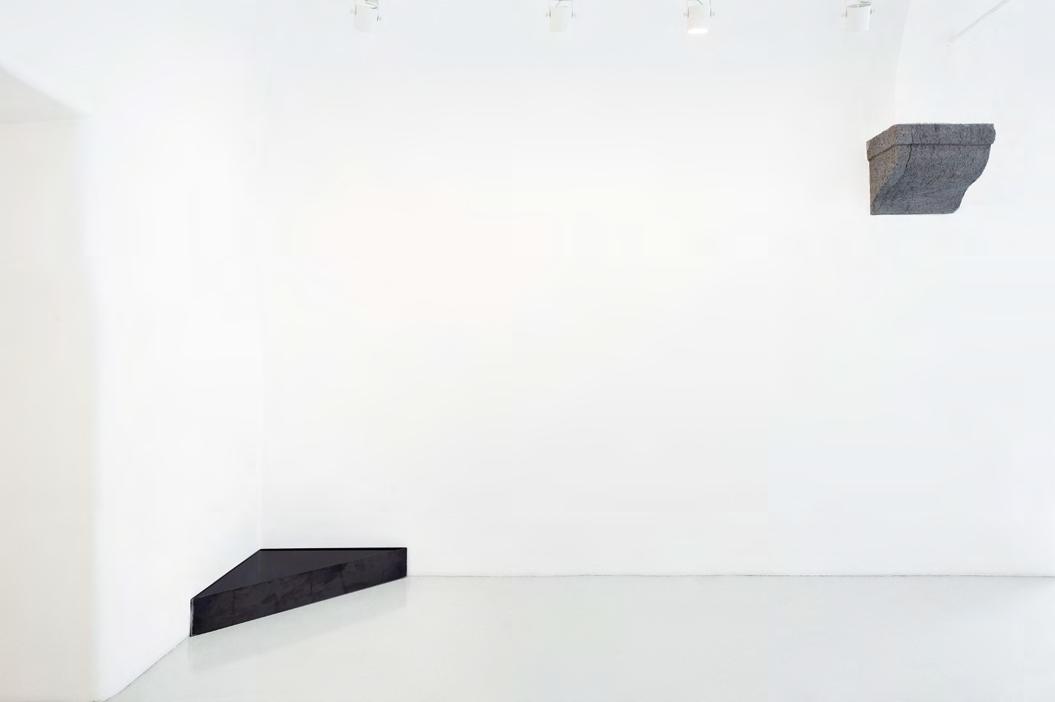
A galvanized metal triangular basin contains 100 liters of black liquid which becomes the volume and structure of the work and is closely interconnected with the basin, without which it could not exist.






A pile of marble and stone slabs from which a corner has been cut in such a manner that an empty, cubic space is formed between the stratification of the slabs and the two walls. In this manner, sculpture and architecture are fused into each other.
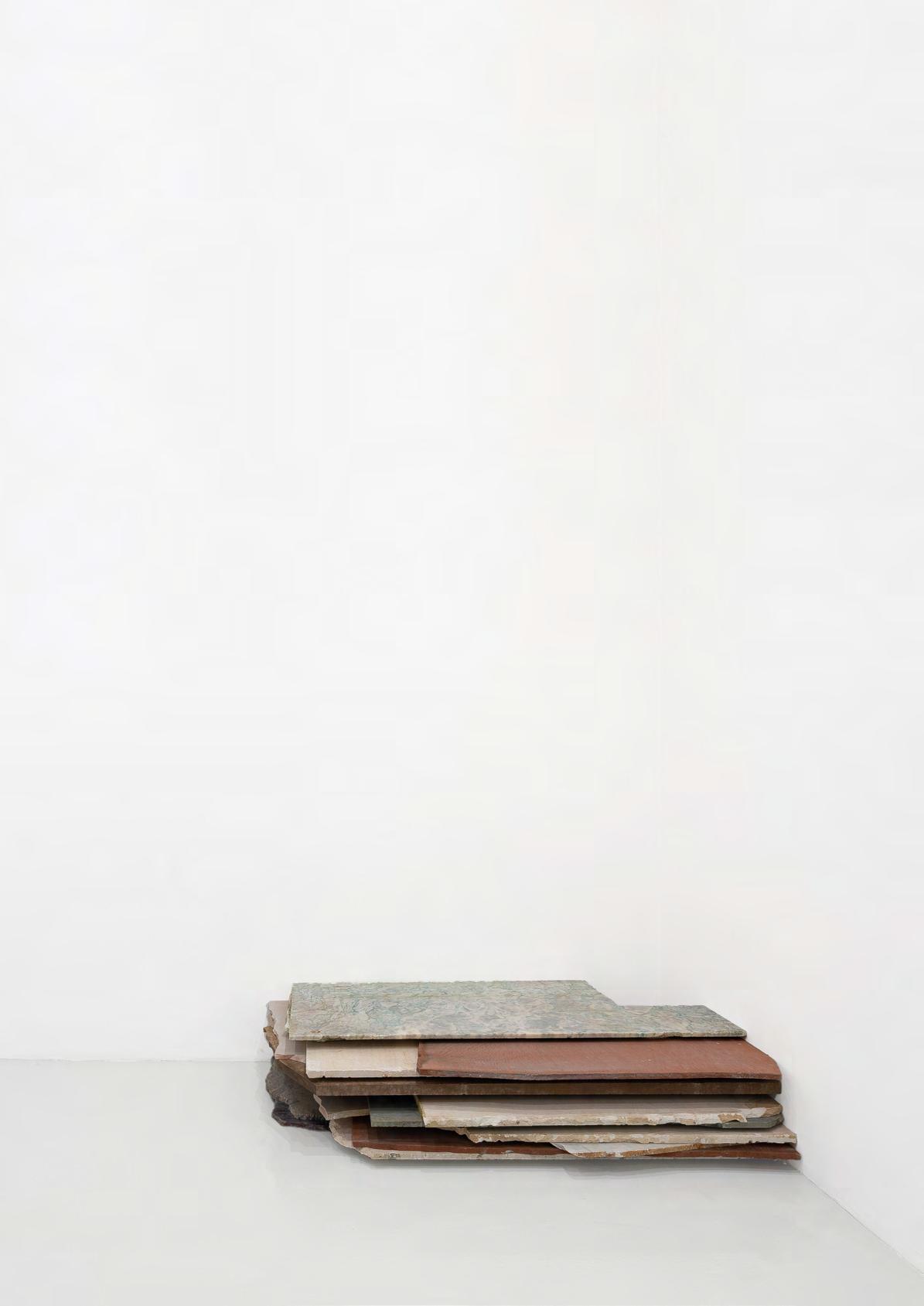

Three quotations from Peter Handke’s novel entitled Die Hornissen (The Hornets) are engraved onto three sheets of polished aluminum: “He only gets excited about that which he does not know”, “What he does know, leaves him indifferent”, “If he knows about something, but is unable to ascertain exactly what it is, he is enticed to know about it”. The mirrorlike surface of the aluminum renders the sculpture permeable to the context in which it lives.


A block of highly polished bronze from which a longstemmed flower emerges, bending as it is pushed against the wall and assuming the geometry of the wall. The curve of the sculpture is formed by the juxtaposition of forces between the full volume of the block and the void of the corner.


The inside of two open pages of a newspaper has been cut out, preserving only the edges of the pages and a word close to them.
The work is a delimited void that results from the transformation of a fullness saturated with information and stories that are replaced every day by others in a continuous layering.


A page of a daily newspaper were erased leaving only the word “empty” visible.


The word GOD is enshrined in two granite stones, on one face are engraved the letters G and D and on the other the letter O, the word is complete only when the two stones are joined and the word is not visible to the beholder, as invisible as the subject the word represents.
Little God, 2025 stones, 18 x 18 x 28 cm


A stone has been cut so that it is the same width as the artist’s head. On one of the smooth faces is engraved the phrase “In my beginning is my end” and on the other one is engraved the phrase “In my end is my beginning”.

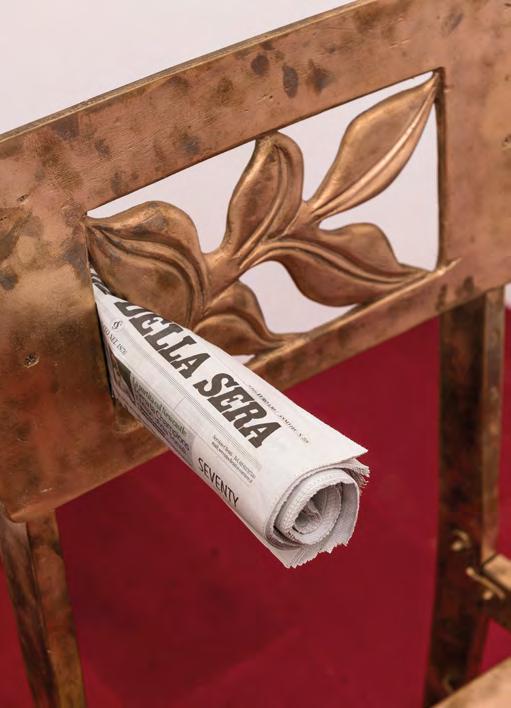
The work is a reproduction in black patinated bronze of the chair that Toronto-based Canadian pianist Glenn Gould (1932-1982) used for all his performances. Made by Gould’s father, the chair is very unusual: it is low and apparently totally unsuitable for its purpose. In the back, a rolled up newspaper is tucked into the top and it must be replaced each day with the current day’s newspaper so that the sculpture is different each day. The original chair is preserved at The National Art Center in Ottawa.


The work consists of a large man’s belt remade in black patinated bronze. The belt is oversized so that it can hold two people and it is a tribute to Cy Twombly. During the last period of his life Twombly sometimes had his assistant support him when he had to paint his large canvases so that he would be more stable, For the artst this is the perfect representation of the need to have support from others, the impossibility of being totally sufficient even in seemingly so personal artistic creation. On the belt is engraved the inscription “Solitude is Multitude is Solitude is Multitude” in a circular and infinite manner. The sculpture is suspended at the height at which a belt is usually found and rotates continuously on itself thanks to an overhead motor.


The work is a reproduction of one of the handles designed by philosopher Ludwig Wittgenstein for the house that architect Paul Engelmann built in Vienna in the late 1920s for Margaret StonboroughWittgenstein, sister of the Austrian philosopher. The sculpture is installed on the two faces of the wall. The two handles have an internal device that makes them rotate as if to open a door.


A river stone hung on the wall holds against it, through steel cables, the book Lutheran Letters by Pier Paolo Pasolini. Only a few centimeters of the book are visible enough to read the sentence printed on the bottom of the cover: «Progress as false progress».
Il progresso, 2022 stone, steel cable, clamps, book, 15 x 17 x 35 cm

Paesaggio (02) is a bronze sculpture of a clay block on which a description of a landscape has been written.
Paesaggio (02), 2022 patinated bronze, 36 x 18 x 17 cm
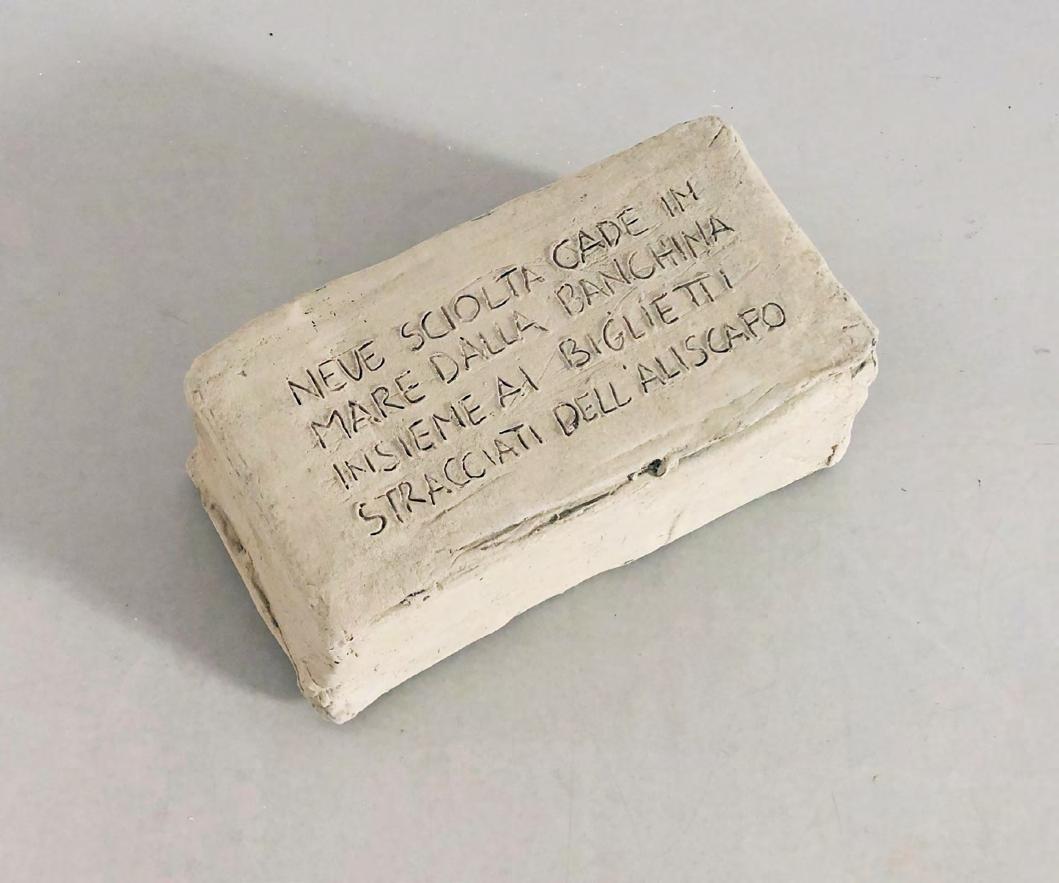

Every time the artist orders a coffee at the bar he uses less than a full sachet of sugar. He keeps the remaining sugar in its sachet, and then in the studio he reseals the sachets with a stapler. He lines them up between two pieces of bronze, one at the beginning and one at the end of the row, until the line of half-full sachets reaches a meter in length. Time has reached its own unit of measure, the meter, the one invented by man to build and give an order to the things that surround us.
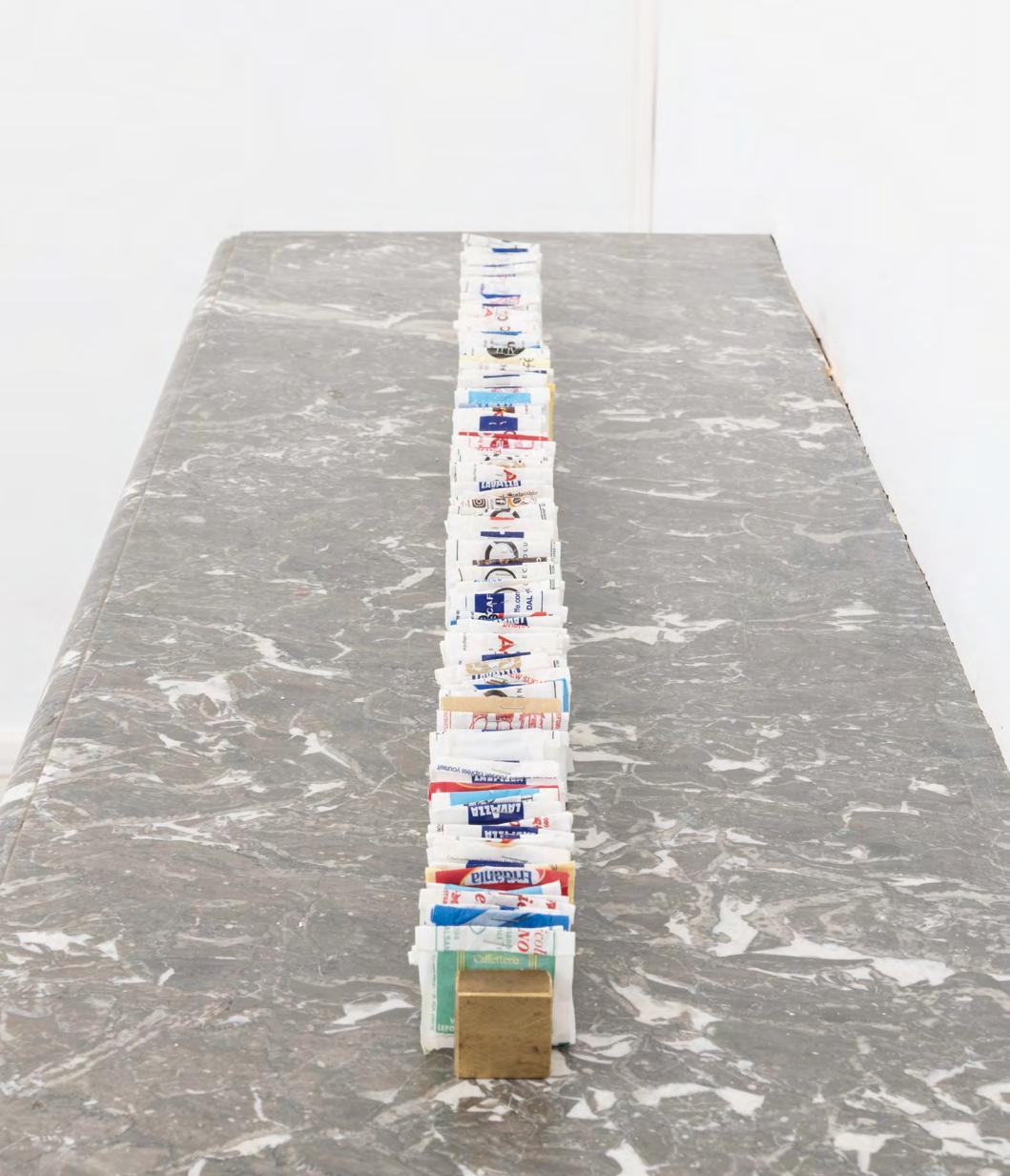

An artist’s used shoe lying upside down on the floor with a stick of incense stuck in a small hole in the sole. While the incense is wearing out, it falls onto the sole and by burning it lets its scent spread through the air.

installation view at Studio Trisorio’ showroom Naples, 2021



Fifty-one books, read by the artist over the course of one year, are lined up, one after another, for the length of one meter.
Two blocks of stone – also measuring one meter in length with one being as wide as the shortest side (plus 4 cm) of the deepest book, and the other as wide as the longest side (4 cm) of the tallest book – have been hallowed out and joined together to house the books which are positioned in the same chronological order in which they were read.
Each book has its own customized position within the stone structure so that the upper and lower edges of the books are perfectly aligned in such as manner as to form a compact parallelepipedon.
Untitled (One Metre of Read Books), 2021 stone, books, nylon, 31,5 x 100 x 21,5 cm


A piece of coral is inserted in the missing part of a metal frame measuring one square meter. The dimensions of the coral correspond exactly to that of the missing piece of metal and this natural element interrupts and, concurrently, re-established the continuity of the square meter conventionally chosen by man as a spatial unit of measurement.
Natural History (Square Metre and Coral), 2021 steel, branch of red coral, 100 x 100 x 5 cm


A pearl is inserted in the missing part of a metal frame measuring one square meter. The dimensions of the pearl correspond exactly to the missing piece of metal and this natural element produced by an oyster interrupts and, concurrently, re-established the continuity of the square meter conventionally chosen by man as a spatial unit of measurement.
Natural History (Square Metre and Pearl), 2021 steel, pearl, 100 x 100 x 4 cm


A piece of coral is inserted in the missing part of a metal cube. The dimensions of the coral correspond exactly to that of the missing piece of metal and this natural element interrupts and, concurrently, re-established the continuity of the cube.
Natural History (Cubic Metre and Coral), 2021 steel, coral, 100 x 100 x 100 cm


The spine of a bronze edging is engraved with the phrase: “The final numer of a given infinity”.

A rolled-up magazine fills the hole in a stone formed by the flow of water. The brief period of time related to the weekly magazine is confronted with the much longer period of time of the rock.
La settimana, 2021
stone, weekly magazine, steel cable, 38 x 29 x 14 cm


Cubo con doppia eruzione is part of a series of works realized by the artist using postcards purchased during his travels. The postcard is maintained in a position parallel to the wall by the weight of the bronze cube which, at the same time, conceals part of the landscape. The visible fragments of the postcard are reflected and duplicated on the cube.

A square meter bronze frame contains a row of wire fragments bind together. The wire divides the square in different portions, as in a geometric draw. The length of the wire measures as the height of three members of the artist’s family.
Division of a Square (The Artist’s Family), 2018 brushed bronze, wires, 100 x 100 x 3 cm
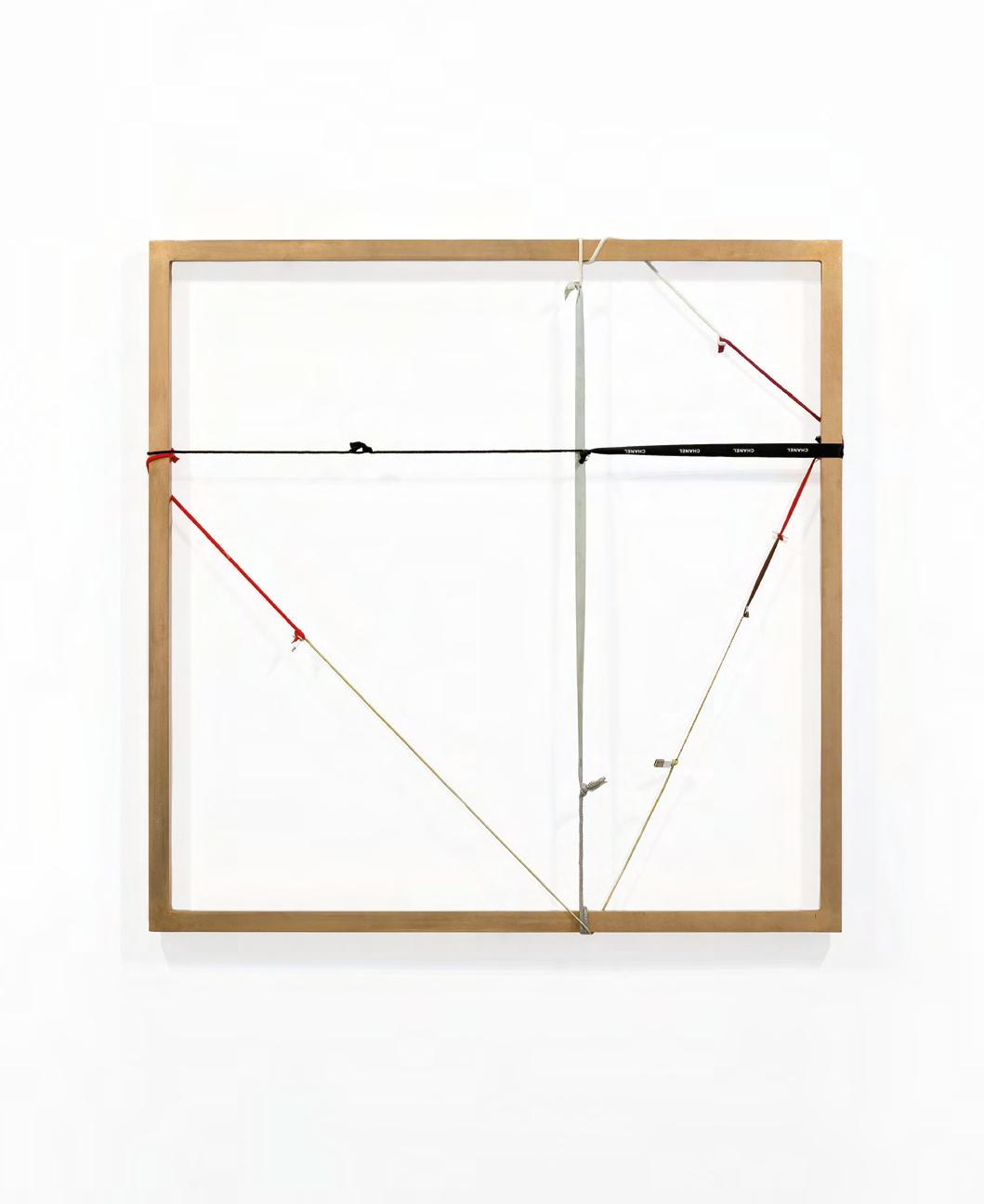
A highly-polished yellow bronze slab featuring four phrases from J.D. Salinger’s Catcher in the Rye engraved along its upper edge. The main character, Holden, utters these phrases at intervals throughout the tale: “People always think something’s all true”, “People never notice anything”, “People are always ruining things for you”, “People never give your message to anybody”. Two fruits are placed on the bronze plate: as time goes by, their mute presence needs to be replaced. Viewers who lean over the highly-polished surface mirror themselves in it and become part of the work. The sculpture is a collage of relationships associated with different time periods: the eternal time of bronze and the engraved writing, the immobile but limited time of the slab with the fruits on it, and the transitory time of people passing by and being reflected.
Square Meter with Holden, Fruits and Person, 2019 polished bronze, fruits, 5 x 100 x 100 cm
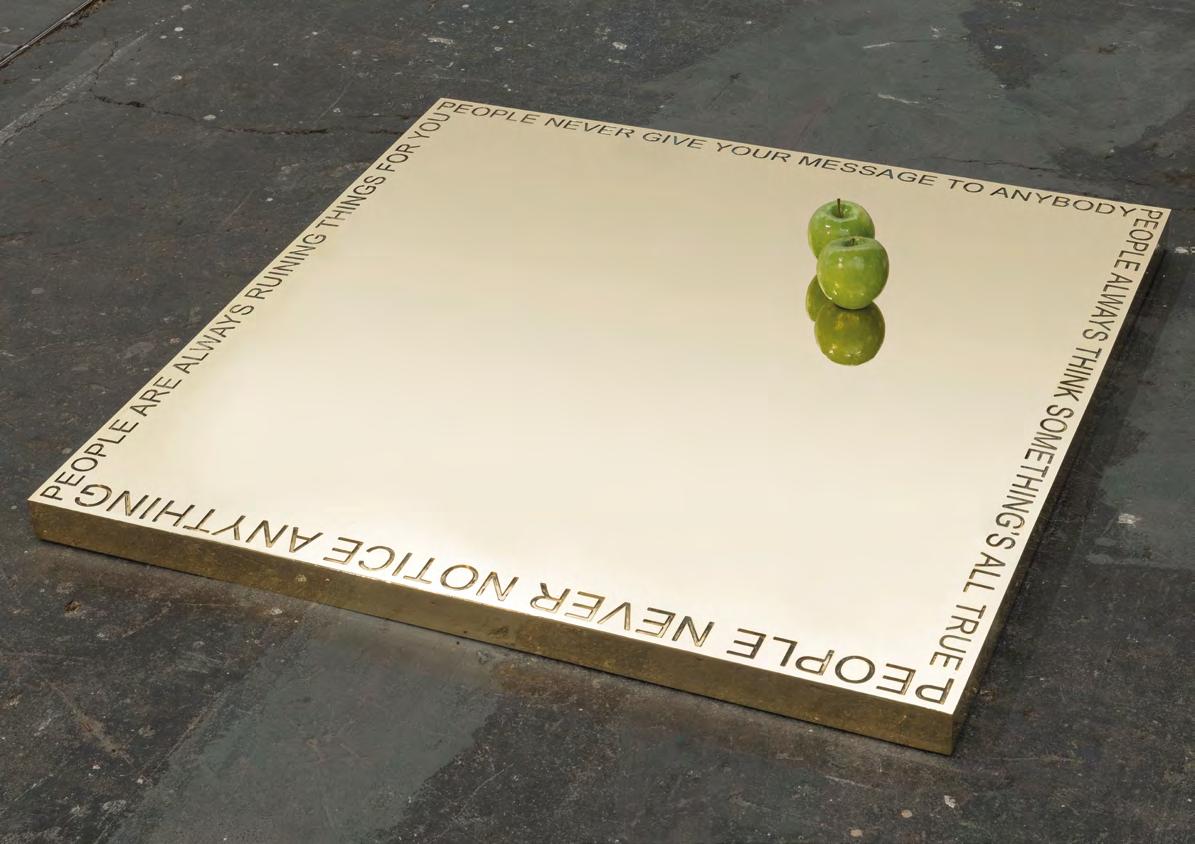
This work blocks time, as defined by the agenda, on the world through the cube’s instable pressure.
World with Cube, 2019 bronze, agenda, 30 x 49 x 17 cm (with agenda)

A block of marble was cut to fill the hollow between two agendas from different years. Each agenda has a pre-established one-year time span: the year being an invention of man, delimiting his finiteness. On the contrary, the stone has an incredibly long time span, one that began far earlier than agenda time and is destined to last, far, far longer. The title describes the numbers of years separating the agendas.

The longest side of a book defines the dimensions of a marble cube. Afterwards a portion is removed to insert the book inside the cube. This brings the starting integrity of the cube back.





Naples gazes at the Moon a distance of 384,400 km and the length of the phrase engraved on the bronze postcard corresponds to the thirty-eight billion four hundred and forty millionth part of this distance.


A four meters tube realized in clay has been divided in two parts by folding it in half. Then two molds have been made from that and two wax postives and at last two white bronze sculptures. The two parts of the tube are installed so as to being separated by a wall.


A distance of 20.95 meters - which corresponds precisely to the diagonal of the two extreme corners of the artist’s house - separates the two halves of the Ball (House)
Ball (House), 2017 white bronze, ø 45 x 23 cm, ø 61 x 21 cm, (distance 20.95 m), ed. 3


The two parts of the work Block (city) are installed at a 1 km distance from each other.

The two parts of the work Slab (Hand) have been placed at a distance of 20 cm apart maintaining the same distance that there is between the tip of the artist’s right hand thumb and the tip of his little finger at its maximum extension.

FRANCESCO ARENA
Francesco Arena was born in Torre Santa Susanna, Brindisi, in 1978 and lives and works in Cassano delle Murge, Bari. His works have been exhibited in numerous solo and group exhibitions, in both public and private venues: Fondazione Nicola del Roscio, Rome, 2023; Casa di Goethe, Rome, 2022; Palazzo d’Avalos, Procida, 2022; Palazzo Borromeo, Milan, 2022; MAXXI L’Aquila, 2022; Nogueras Blanchard Gallery, Barcelona, 2022; Walker Art Center, Minneapolis, 2021; Museo Madre, Naples, 2021; Kyiv History Museum, Kiev, 2021; Galleria Raffaella Cortese, Milan, 2021; Metropolitan Museum of Manila, 2020; Collezione Giancarlo e Danna Olgiati, Switzerland, 2020; Sprovieri Gallery, London, 2019; Kunstmuseum St. Gallen, Switzerland, 2018; PYFF, Ping Yao, Shanxi, China, 2018; Unlimited, Art Basel, 2017; Frac Champagne-Ardenne, Reims, 2012; Museion, Bolzano, 2012; Monitor, Rome, 2011; Peep Hole, Milan, 2011; Art Statement Art Basel, 2010. In 2022, the artist participated in the Bangkok Art Biennale with the work Daily Stone. In 2013, he took part in the Vice Versa exhibition project for the Italian pavilion at the 55th Venice Biennale. In 2014, his work entitled Posatoi became part of the Nancy Olnick and Giorgio Spanu Italian Art collection in Garrison, New
York. In 2019, he was one of the winners of the Fifth Edition of the Italian Council promoted by the Ministry of Cultural Heritage. Francesco Arena’s works are in major national and international museum collections such as the Walker Art Center in Minneapolis, the Philadelphia Art Museum in Philadelphia; the Magazzino Italian Art in Cold Spring (NY); the Castello di Rivoli; the MAXXI Museum in Rome; the Museion in Bolzano; the Madre Museum in Naples, the Capodimonte Museum in Naples. In 2019, Francesco Arena, 5468 days, his monographic catalogue which presents a selection of some sixty of his works realized between 2004 and 2019, was published by Skira. He has been represented by the Studio Trisorio since 2017, where he had the exhibitions Passaggio, 2017 and Otto Angoli, 2021.

FRANCESCO ARENA
Napoli, Riviera di Chiaia, 215 +39 081 414306
Napoli, Via Carlo Poerio, 110 +39 081 5276011
Napoli, Via Carlo Poerio, 116 +39 081 3508195
info@studiotrisorio.com studiotrisorio.com
